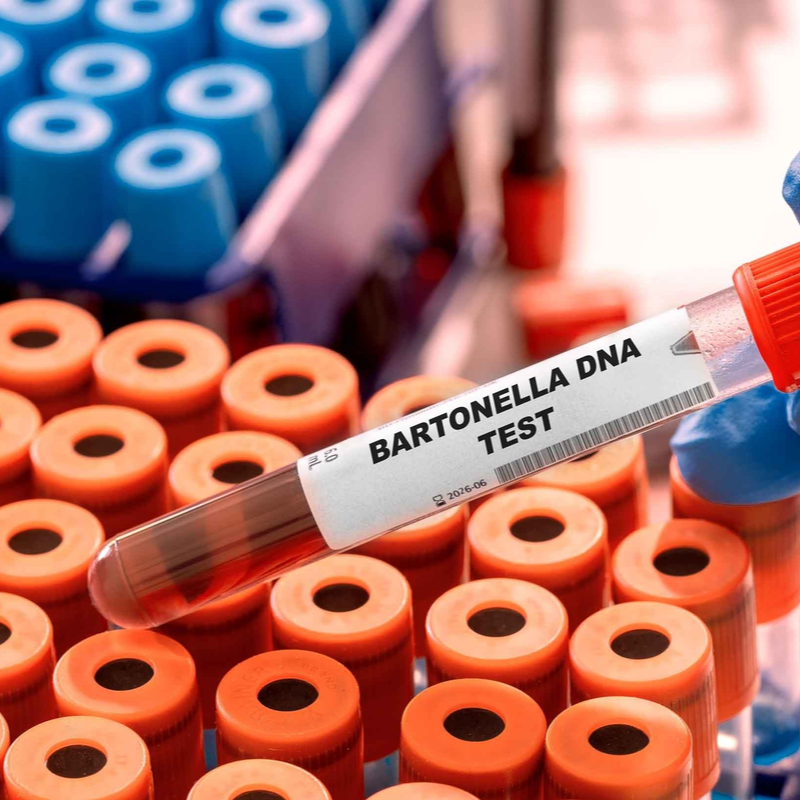
What is the Bartonella weisii pathogen?
The Bartonella weisii pathogen is more commonly known today as Bartonella bovis. It is a pathogenic bacterium that belongs to the genus of Bartonella. Like other Bartonella species, B. weisii is rod-shaped and gram-negative. It is also relatively small, aerobic and oxidase-negative. The bacterium was first isolated from European ruminants, more precisely from cattle. In the meantime, however, the pathogen has also been found in a variety of domestic mammals and wild animals. Although a Bartonella weisii infection in cattle is usually asymptomatic, the disease can nevertheless cause endocarditis and/or bacteraemia.
How is Bartonella weisii transmitted?
Researchers have found that there are the following factors that can lead to infection with Bartonella weisii:
- transmission occurs through certain arthropods,
- Ticks and/or flies as possible vectors,
- Environmental factors, such as certain geographical features favouring, for example, the presence of the arthropods and/or ticks,
- Scratches and/or bites from infected dogs or cats
How does infection with the Bartonella weisii pathogen occur?
The Bartonella weisii pathogens settle in the innermost layer of the blood vessels, the so-called endothelial cells, after transmission. Some of the Bartonella weisii pathogens enter the bloodstream. This leads to an infection of the red blood cells (erythrocytes). The Bartonella weisii pathogen divides within the erythrocytes and multiplies in this way until a critical population density is reached.
In which countries do the Bartonella weisii pathogens occur particularly frequently?
For the first time, the Bartonella weisii pathogen was isolated from cattle in French Guiana, South America. In the meantime, however, the bacterium has also been detected in France, the USA and the Ivory Coast in West Africa. Researchers assume, however, that the pathogen is spread worldwide. In addition to cattle, the Bartonella weisii pathogen has also been isolated in cats.
How was it possible to isolate the Bartonella weisii pathogen in cattle?
The isolation of the Bartonella bovis pathogen was achieved using PCR-positive blood samples from the cattle. The researchers had a total of 224 PCR-positive bovine blood samples. The isolation of the pathogen was successful in 223 blood samples, i.e. with one exception. During isolation, the molecular heterogeneity of the isolates was investigated. This was done on the basis of the sequence analyses of gltA, ITS, rpoB genes, ERIC-PCR and a established multilocus sequence typing method (MLST). Within the framework of the isolation experiments of the pathogen, the carrier rate of Bartonella weisii in ticks was also investigated.
Nowadays, molecular diagnostic tests, such as the PCR method, are usually used to diagnose the bacterium . Furthermore, molecular diagnosis of extracted whole blood is a standard diagnostic procedure.
What were the study results of the analysis of the Bartonella weisii pathogen?
The Bartonella weisii pathogen was detected in ten cases out of a total of 224 bovine blood samples. This corresponds to 4.5 percent. Of these 4.5 percent, the pathogen was detected in three beef cattle (1.3 percent) and in seven dairy cattle (3.1 percent). Researchers were able to detect two specific tick species, Haemaphysalis bispinosa and Rhipicephalus (Boophilus) microplus as vectors. Using the MLST method, the genetic heterogeneity of the isolates could be determined.
Researchers have found that the Bartonella weisii pathogen causes minimal harm to its host (in this case, cattle) . The bacterium maintains a relatively peaceful coexistence with its host animal, making it very different in terms of its survival strategy from other pathogens, which can quickly cause fatal diseases. An example of this is anthrax. Anthrax depends on the rapid death of its host animal in order to be able to release as many spores as possible into the environment.
What diseases can a Bartonella weisii infection lead to in animals?
A Bartonella weisii infection can cause endocarditis or bacteraemia in animals. The disease endocarditis is an infection of the inner lining of the heart. The heart valves are particularly affected. Bacteraemia, on the other hand, describes the presence of bacteria in the bloodstream, resulting in an infection . Endocraditis often occurs in cattle. Only in a few cases, however, can this disease be attributed beyond doubt to a Bartonella weisii infection. For this reason the diagnosis of endocarditis in cattle is often a challenge for veterinarians . To make matters worse, endocarditis in cattle is often asymptomatic. The most common pathogens diagnosed in connection with endocarditis in cattle are Trueperella pyogenes, which is also known as Arcanobacterium pyogenes , Enterobacteriaceae and Streptococcus species. However, other organisms can also contribute to the development of the disease, which is why the true cause of endocarditis can only be determined beyond doubt when the animal is slaughtered or at the time of the autopsy .
Is the Bartonella weisii pathogen dangerous for humans?
If a cat suffers from a Bartonella weisii infection, the bacterium also poses a potential danger to humans. It can cause a zoonosis. Should humans become infected with the Bartonella weisii pathogen, the following clinical pictures can develop:
- Endocarditis: Infection of the inner lining of the heart, which mainly affects the heart valves,
- Fever,
- Swelling of the lymph nodes (lymphadenopathy),
- Peliosis hepatis: Disease of the liver, which manifests itself by blood-filled cysts.
How is a Bartonella weisii infection treated?
In animals, Bartonella weisii infection is treated by the following antibiotics:
- Doxycycline,
- Gyrase inhibitors,
- Macrolide antibiotics
Although the
preparations ensure that the symptoms subside,
does not necessarily completely eliminate the
bacterium in every infected animal. Therefore, reinfections often occur at a later time.
